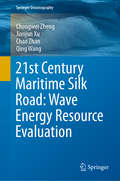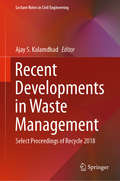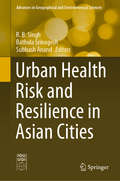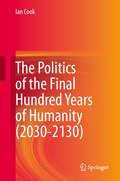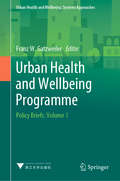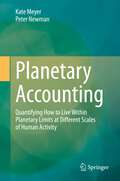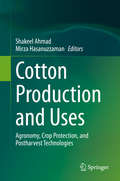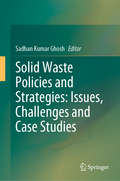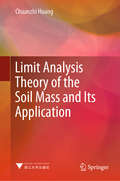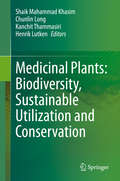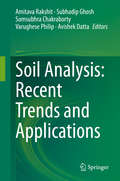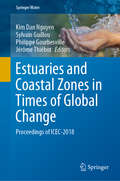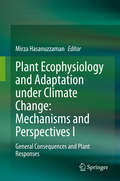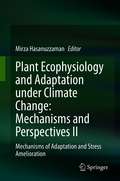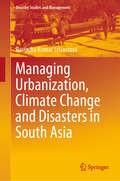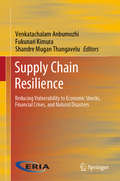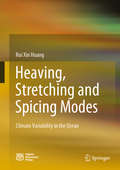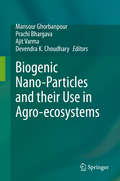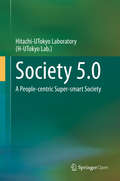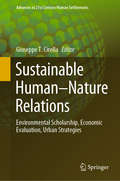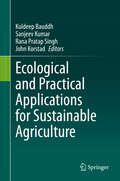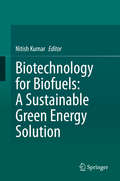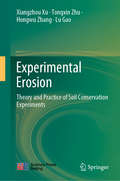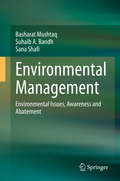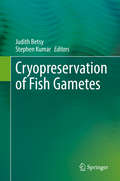- Table View
- List View
21st Century Maritime Silk Road: Wave Energy Resource Evaluation (Springer Oceanography)
by Chongwei Zheng Jianjun Xu Chao Zhan Qing WangThis book focuses on the evaluation of wave energy in the Maritime Silk Road. Firstly, it compares wave energy and other main energy sources, and then discusses the various disadvantages. It also presents the current research and the difficulties of wave energy evaluation, and systematically analyzes the climatic characteristics of the wave energy, including the temporal–spatial distribution and climatic trend of a series of key factors (e.g. wave power density, availability, richness, stability, energy direction, energy storage). It then describes the design of a short-term forecasting scheme and a long-term projection scheme of wave energy suitable for the Maritime Silk Road, to serve as a plan for the daily operation and long-term development of wave energy. Further, it highlights the wave energy analysis and decision-making in the context of the remote islands and reefs, using Sri Lanka is taken as a case study. Lastly, it presents the first wave energy resource dataset for the Maritime Silk Road.This book is one of a series of publications on the 21st century Maritime Silk Road (shortened as “Maritime Silk Road”) that covers the characteristics of the marine environment and marine new energy, remote islands and reef construction, climate change, early warning of wave disasters, legal escort, marine environment and energy big data construction, contributing to the safe and efficient construction of the Maritime Silk Road. It aims to improve our knowledge of the ocean, and so improve the capacity for marine construction, enhance the viability of remote islands and reefs, ease the energy crisis and protect the ecological environment and improve the quality of life of residents along the Maritime Silk Road, as well as to protect the rights, and interests of the countries and regions participating in the construction of the Maritime Silk Road. This book is a valuable reference resource for decision-makers, researchers, and marine engineers working in the related fields.
Recent Developments in Waste Management: Select Proceedings of Recycle 2018 (Lecture Notes in Civil Engineering #57)
by Ajay S. KalamdhadThis volume presents select papers presented during the Second International Conference on Waste Management held at IIT Guwahati. The book comprises of eight sections, and deals with various technologies associated with curbing of different environmental issues as well as management and legislative policies associated with them. This book will be of interest to various researchers, students, policy makers and people who pursue keen interest in the waste management techniques and policies.
Urban Health Risk and Resilience in Asian Cities (Advances in Geographical and Environmental Sciences)
by R. B. Singh Bathula Srinagesh Subhash AnandThis book focuses on understanding urban vulnerability and risk mitigation, advancing good health and wellbeing, and analysing resilience measures for various Asian cities. Today, cities are the dominant human habitat, where a large number of environmental, social, cultural and economic factors have impacts on human health and wellbeing. Cities consist of complex, dynamic, socio-ecological, and technological systems that serve multiple functions in human health and wellbeing. Currently half of Asia’s population is urban, and that figure is expected to rise to 66 percent by 2050. Since urban areas are often most vulnerable to hazards, the people living in them need good health infrastructure facilities and technological support at various scales. As such, the need of the hour is to enhance the adaptive capacity, strengthen resilience, reduce vulnerability, and take risk mitigation measures in urban areas, which requires a systematic approach based on science–policy interface that is transformative, trans-disciplinary and integrative for a sustainable urban future. Global sustainable development goals are closely tied to urban human health and wellbeing: (1) the third of the United Nations’ Sustainable Development Goals is to “Ensure healthy lives and promote wellbeing for all at all ages” and (2) the eleventh is to “Make cities inclusive, safe, resilient and sustainable”. By addressing these goals, this book offers a highly useful resource for anyone concerned with healthy and resilient cities in Asia, today and tomorrow.
The Politics of the Final Hundred Years of Humanity (2030-2130)
by Ian CookThis book is the first book that looks at both the politics of maintaining the trajectory toward humanity’s final hundred years and the politics of those final hundred years. It is the first book to take up theoretical and practical aspects with respect to both the movement toward and events during these final hundred years. As a result, it is the first book that attempts to provide a more complete picture of the politics of catastrophic human-caused environment change.The fact that the book provides a way into the variety of policy problems that catastrophic human-caused environment change is creating means that it is also important to those in Public Policy. The book also raises a series of philosophical and ethical questions associated with human rights, which are significant to those who study Political Philosophy (and some of those who study Law), international action to mitigate the effects of climate change, the nature of science and the limitations of political institutions.
Urban Health and Wellbeing Programme: Policy Briefs: Volume 1 (Urban Health and Wellbeing)
by Franz W. GatzweilerThis book is a compilation of the policy briefs produced by the International Science Council’s program on Urban Health and Wellbeing: A Systems Approach over the past five years. Intended for urban decision-makers at all levels, it highlights policy-relevant findings and research insights to encourage the co-creation of knowledge for healthy urban environments and people. The book shows how variations on the systems approach developed and promoted by the program have been implemented in regions around the world and contributed to improving urban health. These policy briefs summarize research findings and scientific events concerning urban health-related topics that are relevant for public health professionals, urban planners, urban stakeholder groups and the public at large.
Planetary Accounting: Quantifying How to Live Within Planetary Limits at Different Scales of Human Activity
by Peter Newman Kate MeyerThis book presents a novel way to enable people, regardless of their scale of influence, to take responsibility for global environmental problems including climate change. It introduces a new framework called Planetary Accounting, which allows the Planetary Boundaries, non-negotiable limits for the environment, to be translated into limits for human activity. It shows how such limits can be broken down into chunks that can be managed at different levels (from individual and community, to business and sector levels, to cities and regions), and at any level of government. The book begins by summarising the science of climate change and introducing the notion of the Anthropocene – the “human age”. It highlights the importance of returning to and remaining within the Planetary Boundaries but shows that we can’t realistically do so unless we have a new approach to environmental accounting.The book then outlines how Planetary Accounting furnishes this new approach by combining sustainability science, change theory, and environmental accounting to create a scalable framework for environmental management that encourages systemic and individual change. The details of the science of and our human contribution to ten critical human pressures are then presented, and the book concludes with a guide for those seeking to apply Planetary Accounting in practice. Planetary Accounting could form the scientific underpinning of behaviour change programs, guide the development of policy and regulations, and provide both the basis for environmental laws, and the foundation of future global environmental agreements. It has been 50 years since the first views from space showed a blue planet alone in our solar system. This book is an historic opportunity to provide humanity for the first time with sufficient information to begin implementing Planetary Accounting.
Cotton Production and Uses: Agronomy, Crop Protection, and Postharvest Technologies
by Mirza Hasanuzzaman Shakeel AhmadThis book provides a comprehensive and systematic overview of the recent developments in cotton production and processing, including a number of genetic approaches, such as GM cotton for pest resistance, which have been hotly debated in recent decades. In the era of climate change, cotton is facing diverse abiotic stresses such as salinity, drought, toxic metals and environmental pollutants. As such, scientists are developing stress-tolerant cultivars using agronomic, genetic and molecular approaches. Gathering papers on these developments, this timely book is a valuable resource for a wide audience, including plant scientists, agronomists, soil scientists, botanists, environmental scientists and extention workers.
Solid Waste Policies and Strategies: Issues, Challenges and Case Studies
by Sadhan Kumar GhoshThe book focuses on the challenges faced by urban areas in the context of handling waste in an environmentally and socially acceptable manner. It also discusses effective waste management approaches, which differ according to culture, climate, and socio-economic variables, as well as institutional volume. Presenting selected, high-quality papers from IconSWM 2018, the book explores a number of waste management methods with the help of case studies.
Limit Analysis Theory of the Soil Mass and Its Application
by Chuanzhi HuangThis book establishes the equations of limit analysis and provides a complete theoretical basis for foundation capacity, slope stability, and earth pressure. It is divided into three parts, the first of which discusses the failure mode and fundamental equation of soil mass. The second part addresses the solution methods for limit analysis, including the characteristic line method, stress field method, limit equilibrium method, virtual work equation-based generalized limit equilibrium method and generalized limit equilibrium method for the surface failure mode. Lastly, the third part examines the application of the limit analysis theory to soil mass.
Medicinal Plants: Biodiversity, Sustainable Utilization and Conservation
by Shaik Mahammad Khasim Kanchit Thammasiri Chunlin Long Henrik LutkenPlants have been a source of medicines and have played crucial role for human health. Despite tremendous advances in the field of synthetic drugs and antibiotics, plants continue to play a vital role in modern as well as traditional medicine across the globe. In even today, one-third of the world’s population depends on traditional medicine because of its safety features and ability to effectively cure diseases. This book presents a comprehensive guide to medicinal plants, their utility, diversity and conversation, as well as biotechnology. It is divided into four main sections, covering all aspects of research in medicinal plants: biodiversity and conservation; ethnobotany and ethnomedicine; bioactive compounds from plants and microbes; and biotechnology. All sections cover the latest advances. The book offers a valuable asset for researchers and graduate students of biotechnology, botany, microbiology and the pharmaceutical sciences. It is an equally important resource for doctors (especially those engaged in Ayurveda and allopathy); the pharmaceutical industry (for drug design and synthesis); and the agricultural sciences.
Soil Analysis: Recent Trends and Applications
by Amitava Rakshit Subhadip Ghosh Somsubhra Chakraborty Varughese Philip Avishek DattaSoil analysis is critically important in the management of soil-based production systems. In the absence of efficient methods of soil analysis our understanding of soil is pure guesswork. Ideally the pro-active use of laboratory analysis leads to more sustainable soil productivity. Unfortunately, most of the world’s agriculture is still reactionary, waiting for obvious yield declines to occur before taking action to identify the reasons. The modern soil laboratory is pivotal to informing soil managers what adaptive practices are needed to address chemical and physical imbalances before they occur, and the intelligent adaptive use of laboratory data not only greatly speeds up and reduces the cost of empirical soil study, but can even render it unnecessary. This book provides a synopsis of the analytical procedures used for soil analysis, discussing the common physical, chemical and biological analytical methods used in agriculture and horticulture. Written by experienced experts from institutions and laboratories around the globe, it provides insights for a range of users, including those with limited laboratory facilities, and helps students, teachers, soil scientists and laboratory technicians increase their knowledge and skills and select appropriate methods for soil analysis.
Estuaries and Coastal Zones in Times of Global Change: Proceedings of ICEC-2018 (Springer Water)
by Philippe Gourbesville Kim Dan Nguyen Sylvain Guillou Jérôme ThiébotThis book is a collection of extended papers based on presentations given during the ICEC 2018 conference, held in Caen, France, in August 2018. It explores both the limitations and advantages of current models, and highlights the latest developments concerning new numerical schemes, high-performance computing, multi-physics and multi-scale methods, and better interaction with field or scale model data. Accordingly, it addresses the interests of practitioners, stakeholders, researchers, and engineers active in this field.
Plant Ecophysiology and Adaptation under Climate Change: General Consequences and Plant Responses
by Mirza HasanuzzamanThis book presents the state-of-the-art in plant ecophysiology. With a particular focus on adaptation to a changing environment, it discusses ecophysiology and adaptive mechanisms of plants under climate change. Over the centuries, the incidence of various abiotic stresses such as salinity, drought, extreme temperatures, atmospheric pollution, metal toxicity due to climate change have regularly affected plants and, and some estimates suggest that environmental stresses may reduce the crop yield by up to 70%. This in turn adversely affects the food security. As sessile organisms, plants are frequently exposed to various environmental adversities. As such, both plant physiology and plant ecophysiology begin with the study of responses to the environment. Provides essential insights, this book can be used for courses such as Plant Physiology, Environmental Science, Crop Production and Agricultural Botany.Volume 1 provides up-to-date information on the impact of climate change on plants, the general consequences and plant responses to various environmental stresses.
Plant Ecophysiology and Adaptation under Climate Change: Mechanisms of Adaptation and Stress Amelioration
by Mirza HasanuzzamanThis book presents the state-of-the-art in plant ecophysiology. With a particular focus on adaptation to a changing environment, it discusses ecophysiology and adaptive mechanisms of plants under climate change. Over the centuries, the incidence of various abiotic stresses such as salinity, drought, extreme temperatures, atmospheric pollution, metal toxicity due to climate change have regularly affected plants and, and some estimates suggest that environmental stresses may reduce the crop yield by up to 70%. This in turn adversely affects the food security. As sessile organisms, plants are frequently exposed to various environmental adversities. As such, both plant physiology and plant ecophysiology begin with the study of responses to the environment. Provides essential insights, this book can be used for courses such as Plant Physiology, Environmental Science, Crop Production and Agricultural Botany.Volume 2 provides up-to-date information on the impact of climate change on plants, the general consequences and plant responses to various environmental stresses.
Managing Urbanization, Climate Change and Disasters in South Asia (Disaster Studies and Management)
by Ravindra Kumar SrivastavaThis book offers essential insights into potential catastrophic events that might befall upon the emerging urban landscape in South Asia, and which are due to hazards, risks and vulnerabilities inherent in the region’s geophysical location, as well as due to climate change and unplanned urbanization. It highlights major physio-graphic, demographic, geological and geophysical indicators that are responsible for changing the pattern and trend of urbanization in South Asia – a crucial issue in view of emerging threats of climate change, and changes in the demographic profile. The book addresses the disaster management scenario in South Asia, manifestations of climate change in the region and various urban setups under climate-change-induced risks. Further, it elaborates on the challenges of urbanization-based neo-risks and vulnerabilities, which manifest in the form of slum area growth, piling and littering of waste and filth, new health risks, groundwater contamination, air pollution, highly energy-dependent lifestyles, poverty, socio-economic tensions, etc. It also critically examines the institutional mechanisms for disaster risk reduction (DRR), climate change adaptation (CCA) and urban governance, and suggests appropriate changes in the governing structure to mitigate these risks. The book draws the attention of urban planners and policymakers to current shortcomings in the administrative and financial structures of local urban bodies. While outlining climate-associated risks and adaptation strategies in South Asia, it also suggests measures for integrating climate change and urban adaption with state's planning processes, and puts forward a risk alleviation platform to bring the risk managers working in different fields together, so that they make concerted efforts to achieve sustainable development. It offers valuable takeaways for researchers, urban planners, those working in industry, consultants, and policymakers.
Supply Chain Resilience: Reducing Vulnerability to Economic Shocks, Financial Crises, and Natural Disasters
by Venkatachalam Anbumozhi Fukunari Kimura Shandre Mugan ThangaveluThis book investigates individual companies’ and industries’ supply chain risk management approaches to identify risk drivers and verify effective risk-reduction measures and business continuity plans.Typically, supply chain risk assessments focus on normative guidelines based on single best practice examples or vulnerability events, and there has been little work exploring how the concepts of supply chain risk management and resilience are related. However, since this relationship has implications for developing integrated response strategies, a clear understanding of the possible consequences is a fundamental step in building socio-economic resilience along the supply chain.Against this background, the book addresses three main topics: firstly, it defines the conceptual and sectoral domains of supply chain risk management and resilience by examining the welfare effects of extreme weather events and other economic shocks on selected global supply chains. It then presents an in-depth analysis of the scope of public–private partnerships to tackle the risks, by empirically exploring supply chain risk effects and information management. Thirdly, it proposes a regional cooperation framework in the context of major supply chain vulnerability events such as disasters and global financial crises.
Heaving, Stretching and Spicing Modes: Climate Variability in the Ocean (Springer Oceanography Ser.)
by Rui Xin HuangThis book is focused on fundamental aspects of climate variability in the ocean, in particular changes of the wind-driven circulation. The vertical movement of isopycnal (isothermal) layers, including their stretching and compression, is called heaving and stretching. A major part of climate variability in the ocean is heaving in nature. Heave is primarily associated with the adiabatic motions of isopycnal layers due to change of wind stress. It is rather difficult to separate the contributions from adiabatic and diabatic processes.Isopycnal analysis has been widely used in climate study; however, it is much more accurate to study the isopycnal layers. Here climate signals are examined in terms of changes of layer depth, layer thickness, layer temperature/salinity, spicity and others.In addition to the traditional Theta-S diagram, the sigma-pi (potential density – potential spicity) diagram can also be used in analyzing water mass property distribution and climate variability. In fact, a radius of signal can be defined rigorously for signals in the sigma-pi diagram; the combination of isopycnal analysis and evaluation of radius of signal provides a powerful tool in analyzing climate variability in the world oceans.
Biogenic Nano-Particles and their Use in Agro-ecosystems
by Ajit Varma Devendra K. Choudhary Mansour Ghorbanpour Prachi BhargavaSeveral nano-scale devices have emerged that are capable of analysing plant diseases, nutrient deficiencies and any other ailments that may affect food security in agro-ecosystems. It has been envisioned that smart delivery systems can be developed and utilised for better management of agricultural ecosystems. These systems could exhibit beneficial, multi-functional characteristics, which could be used to assess and also control habitat-imposed stresses to crops.Nanoparticle-mediated smart delivery systems can control the delivery of nutrients or bioactive and/or pesticide molecules in plants. It has been suggested that nano-particles in plants might help determine their nutrient status and could also be used as cures in agro-ecosystems. Further, to enhance soil and crop productivity, nanotechnology has been used to create and deliver nano fertilizers, which can be defined as nano-particles that directly help supply nutrients for plant growth and soil productivity. Nano-particles can be absorbed onto clay networks, leading to improved soil health and more efficient nutrient use by crops. Additionally, fertilizer particles can be coated with nano-particles that facilitate slow and steady release of nutrients, reducing loss of nutrients and enhancing their efficiency in agri-crops. Although the use of nanotechnology in agro-ecosystems is still in its early stages and needs to be developed further, nano-particle-mediated delivery systems are promising solutions for the successful management of agri-ecosystems. In this context, the book offers insights into nanotechnology in agro-ecosystems with reference to biogenic nanoparticles. It highlights the: • occurrence and diversity of Biogenic Nanoparticles• mechanistic approach involved in the synthesis of biogenic nanoparticles• synthesis of nanoparticles using photo-activation, and their fate in the soil ecosystem• potential applications of nanoparticles in agricultural systems• application and biogenic synthesis of gold nanoparticles and their characterization• impact of biogenic nanoparticles on biotic stress to plants• mechanistic approaches involved in the antimicrobial effects and cytotoxicity of biogenic nanoparticles• role of biogenic nanoparticles in plant diseases management• relevance of biological synthesized nanoparticles in the longevity of agricultural crops • design and synthesis of nano-biosensors for monitoring pollutants in water, soil and plant systems• applications of nanotechnology in agriculture with special refer to soil, water and plant sciencesA useful resource for postgraduate and research students in the field of plant and agricultural sciences, it is also of interest to researchers working in nano and biotechnology.
Society 5.0: A People-centric Super-smart Society
by Hitachi-UTokyo LaboratoryThis open access book introduces readers to the vision on future cities and urban lives in connection with “Society 5.0”, which was proposed in the 5th Basic Science and Technology Plan by Japan’s national government for a technology-based, human-centered society, emerging from the fourth industrial revolution. The respective chapters summarize the findings and suggestions of joint research projects conducted by H-UTokyo Lab. Through the research collaboration and discussion, this book explores the future urban lives under the concept of “Society 5.0”, characterized by the key phrases of data-driven society, knowledge-intensive society, and non-monetary society, and suggests the directionality to which the concept should aim as Japan’s technology-led national vision. Written by Hitachi’s researchers as well as academics from a wide range of fields, including engineering, economics, psychology and philosophy at The University of Tokyo, the book is a must read for members of the general public interested in urban planning, students, professionals and researchers in engineering and economics.
Sustainable Human–Nature Relations: Environmental Scholarship, Economic Evaluation, Urban Strategies (Advances in 21st Century Human Settlements)
by Giuseppe T. CirellaThis book addresses sustainability thinking and the bigger picture, by taking into consideration how and from where contemporary schools of thought emerged approximately a quarter-century ago. Evidence from the literature illustrates a number of key concepts and techniques that have been tested and continue to be tested, within various multi-disciplinary fields, on societal functionality. Research into sustainable societies needs to be sound, ethical, and creative. A cross-sectoral, interdisciplinary examination of challenges and strategies is used to interlink sustainability thinking and human-nature relations. With an ever-growing number of people now concentrated within urban areas, providing not only environmental quality and livable space, but also security and resilient urban systems, is becoming increasingly important. This urbanization trend has overlapped with environmental degradation, consumption of natural resources, habitat loss, and overall ecosystem change. Consequently, the goal is for cleaner, safer societies – with higher standards of living – to excel in support of current and future generational communities. The book tackles these challenges by integrating environmental scholarship, economic evaluation, and urban strategies under one umbrella of thought. The relational paradigms presented include examples that correlate developed and developing countries, socioeconomics and community development, and governance of knowledge and education. As such, the book argues, furthering of knowhow should be accessible and shared in order to achieve maximum innovation and benefit. Sustainability thinking, after all, is a metric for intrinsic human-nature relations in terms of past performance, present development, and future goals. This book discusses this metric and offers novel approaches to growing societies and what we can do next.
Ecological and Practical Applications for Sustainable Agriculture
by Kuldeep Bauddh Sanjeev Kumar Rana Pratap Singh John KorstadRampant industrialization, urbanization, and population growth have resulted in increased global environmental contamination. The productivity of agricultural soil is drastically deteriorated and requires a high dose of fertilizers to cultivate crops. To ensure food security, farmers are compelled to apply excess chemical fertilizers and insecticides that contaminate soil, air, and water. Heavy loads of chemical fertilizers not only degrade the quality of agricultural land but also pollute water and air. Use of chemical fertilizers also accelerate the release of greenhouse gases like nitrous oxide and methane along with nutrient runoff from the watershed in to lower elevation rivers and lakes, resulting in cultural eutrophication.Farming practices globally in developed, developing, and under-developing countries should utilize and promote sustainable methods through viable combined environmental, social, and economic means that improve rather than harm future generations. This can include use of non-synthetic fertilizers like compost, vermicompost, slow-release fertilizers, farmyard manures, crop rotations that include nitrogen-fixing legumes. Organic fertilizers like compost and vermicompost improve soil properties like texture, porosity, water-holding capacity, organic matter, as well as nutrient availability. The purpose of this book is to document the available alternatives of synthetic fertilizers, their mode of action, efficiency, preparation methodology, practical suggestions for sustainable practices, and needed research focus. The book will cover major disciplines like plant science, environmental science, agricultural science, agricultural biotechnology and microbiology, horticulture, soil science, atmospheric science, agro-forestry, agronomy, and ecology. This book is helpful for farmers, scientists, industrialists, research scholars, masters and graduate students, non-governmental organizations, financial advisers, and policy makers.
Biotechnology for Biofuels: A Sustainable Green Energy Solution
by Nitish KumarThe depletion of petroleum-derived fuel and environmental concerns have prompted many millennials to consider biofuels as alternative fuel sources. But completely replacing petroleum-derived fuels with biofuels is currently impossible in terms of production capacity and engine compatibility. Nevertheless, the marginal replacement of diesel with biofuel could delay the depletion of petroleum resources and abate the radical climate change caused by automotive pollutants. Energy security and climate change are the two major driving forces for worldwide biofuel development, and also have the potential to stimulate the agro-industry. The development of biofuels as alternative and renewable sources of energy has become critical in national efforts towards maximum self-reliance, the cornerstone of our energy security strategy. At the same time, the production of biofuels from various types of biomass such as plants, microbes, algae and fungi is now an ecologically viable and sustainable option. This book describes the biotechnological advances in biofuel production from various sources, while also providing essential information on the genetic improvement of biofuel sources at both the conventional and genomic level. These innovations and the corresponding methodologies are explained in detail.
Experimental Erosion: Theory and Practice of Soil Conservation Experiments
by Xiangzhou Xu Tongxin Zhu Hongwu Zhang Lu GaoThis book is the first to systematically explore experimental erosion by integrating theory, erosion observations, and conservation applications. Although numerous books have been published on soil erosion both in English and in Chinese, none has concentrated on experimental studies on the Loess Plateau of China, in an attempt to establish a new sub-discipline: experimental erosion. One main objective of this book is to highlight monitoring and modeling methods for soil scientists who design and conduct experimental studies on soil loss. Another objective, and the most important one, is to make the results of these experiments more generally available. Accordingly, we have gathered and integrated a broad range of experimental results, both published and unpublished. In-depth discussions of the experimental data and new data processing methods are also included. The work covered here represents exemplary studies in the field of soil erosion and conservation, while the new methods and findings presented will provide practical guidance for controlling soil erosion. Hence the book offers a valuable resource for graduate students, soil erosion scientists and engineers, and soil and water conservationists.
Environmental Management: Environmental Issues, Awareness and Abatement
by Basharat Mushtaq Suhaib A. Bandh Sana ShafiIn the current age of science and technology, our lives have become dominated by countless scientific and technological innovations without which the earth would be a much poorer place. Life as we know would become absolutely bleak and boring without the inventions and advances being made all over the globe. In fact, scientific inventions, discoveries and innovations have ushered in a dramatic revolution in virtually every sphere of life. But at the same time, the skewed use of technology is at loggerheads with the environment. We, and our environment, now face a number of critical challenges and it is in response to this that we wrote this book to raise awareness for environmental issues and related management aspects. With a primary focus on Environmental Management – the rational reconciliation of man and nature, which involves the judicious exploitation and utilization of natural resources without disturbing the ecosystem’s balance – it will thus help to improve the relationship between man and environment. Moreover, it offers a wealth of ready-to-use material for advanced undergraduate and graduate students of Environment and Water Management. The book systematically addresses a range of key aspects, e.g. scientific principles, methods and ideas, as well as life-long learning skills for students. Further, it provides a solid foundation for applying scientific approaches to environmental problems.
Cryopreservation of Fish Gametes
by Judith Betsy Stephen KumarUnderstanding the reproductive physiology and endocrinology of fishes is essential for captive maturation and seed production in the field of aquaculture. Studying the spermatology of fishes is a comparatively new focus in aquaculture, which has emerged as an important area of fish research over the past two decades. In this regard, the cryopreservation of fish gametes is a crucial aspect. Moreover, energetics studies of gametes have become essential, considering the loss of vigour in the spermatozoa after cryopreservation.The latest development in this context is the cryopreservation of spermatogonial stem cell, which is also covered in the book, along with detailed information on embryo cryopreservation in fishes and crustaceans. The role of cryopreservation in conservation programmes is another important aspect, one that will especially interest biologists.This book addresses central issues in fish gamete cryopreservation and breeding, while also reviewing the history of cryopreservation. Its most unique feature is the breadth of its coverage, from basic information on reproduction in fishes, to such advanced topics as embryo cryopreservation. Chiefly intended as a handy troubleshooting guide, the book represents a valuable resource for research students in related fields.
